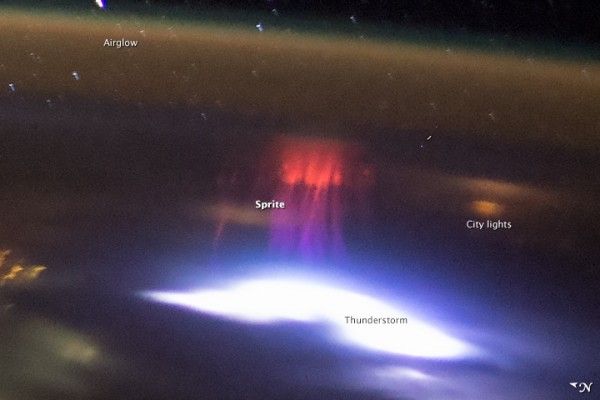
You’ve seen lightning shoot from the bottom of a cloud during powerful thunderstorms. But you’d need to be up high to see what comes from the tops of those same storm clouds. That was the case on August 10, 2015, when astronauts aboard the International Space Station (ISS) captured these red sprites – sometimes called lightning sprites – above a cluster of storms in northwest Mexico.
Here’s a closer view:
Two minutes and 58 seconds later after the first photo on this page was taken, as the ISS was over the coastal Mexican resort of Acapulco, the crew documented another red sprite (see below) over a brilliant white thundercloud and lightning discharge near the coast of El Salvador.
The shorter distance to the storm — about 1,150 km (710 miles) — makes it somewhat easier to see details of the sprite. City lights are a diffuse yellow because they’re shining through clouds.

These photos show the sprite’s tendrils reaching as much as 100 kilometers above Earth’s surface. NASA says:
Sprites are major electrical discharges, but they are not lightning in the usual sense. Instead, they are a cold plasma phenomenon without the extremely hot temperatures of lightning that we see underneath thunderstorms. Red sprites are more like the discharge of a fluorescent tube. Bursts of sprite energy are thought to occur during most large thunderstorm events. They were first photographed in 1989.
Astronaut photographs ISS044-E-45553 and ISS044-E-45576 were acquired on August 10, 2015, with a Nikon D4 digital camera using a 28 millimeter lens, and are provided by the ISS Crew Earth Observations Facility and the Earth Science and Remote Sensing Unit, Johnson Space Center. The images were taken by a member of the Expedition 44 crew. The images have been cropped and enhanced to improve contrast, and lens artifacts have been removed.
Why are sprites so elusive? It doesn’t help that they flash on a millisecond timescale. But also they are above thunderstorms, so they’re usually blocked from view on the ground. Sometimes they’re seen from a distance, or from a high mountain. Astronauts in space also the perfect vantage point for seeing lightning sprites.
Bottom line: Two photos of red sprites – sometimes called lightning sprites – taken on August 10 by astronauts aboard the International Space Station.











